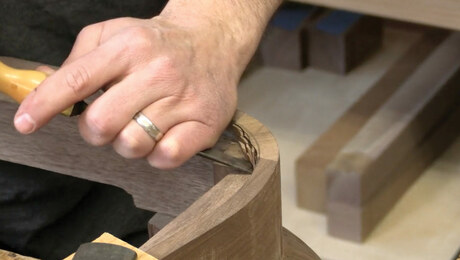The Power of the Simple Scratch Stock
Low-tech tools do things that routers can’t.
Synopsis: A simple tool made up of a wooden holder and a flat metal blade, the scratch stock has been used for centuries to create custom molding profiles and other decorative details. It still comes in handy for those occasions when a router bit doesn’t fill the bill. David Moore makes scratch stocks in batches, shaping the cutters with files. Even when using router bits to do the heavy work, he often refines the profiles using custom scratch stocks. These remarkable hand tools can do any job from simple beads, to inlay, to complex molding profiles.
Learn how to make a scratch stock here
The router is a wonderful tool for creating moldings and decorative details. There are bits that
produce roundovers, ogees, ovolos, scotias, and astragals, to name a few. But despite the growing
field of router jigs, bits, and accessories, there are still times when a router just won’t do. Some details are too delicate for a router to achieve, and there are times when no bit’s profile looks quite right. These are times to reach for a scratch stock, a shopmade tool that
furniture makers have wielded for hundreds of years.
Basically a wooden holder and a flat metal blade, a scratch stock works surprisingly quickly, creating custom molding profiles and other decorative details as well as voids for stringing and other inlay. Unlike a router, the scratch stock can be customized and—if you have a little scrap material on hand—can be had without leaving the shop.
I’ll take you step by step through making this simple tool and show you some great ways to use it.
Low-budget and easy to make
I make scratch-stock holders out of maple because it’s long-lasting and produces minimal friction. I make them from two pieces, screwed together to hold the cutter between them. two 1⁄2-in.-thick strips, 12 1⁄2 in. long and 2 1⁄2 in. wide, provide enough stock to make three holders. I lay out all three on the top blank, leaving 1⁄8 in. between them to allow for the tablesaw kerf.
For best alignment, pre-drill for the screw holes with the blanks clamped together. Be sure to drill the hole in the top blank slightly wider than the diameter of the screw’s threads. This way, the threads won’t bite in the top half of the holder, making it easier to loosen and tighten the cutter. Last, countersink the holes so the screw heads are flush with the face of the top blank.
With the blanks screwed together, use the tablesaw and then the bandsaw to cut them out. Once the holders are separated, lay out the chamfer angles on the end of the holder and carry the lines down the length of the body. Use a handsaw to make angled stop cuts where the chamfers die into the holder’s fence. Then use a chisel to pare away the waste.
From Fine Woodworking #220
For the full article, download the PDF below:
Fine Woodworking Recommended Products

Ridgid EB4424 Oscillating Spindle/Belt Sander























Comments
Purists to the nth degree !!!!!!! Bet he won't drink wine if it wasn't foot stomped. Why take 100 hours to build something with brute force when tools today can replicate virtually anything tools that were used 100 plus years ago in perhaps less than a third of the time. Use of hand tools is no more a Fine Wood Working art than using power tools to build an identical item is crude and crass craft show work. What is important, at least to me is the quality of the workmanship. So he spends 3-5 hours making his scratch stock blades and another 3-5 hours scratching out a table leg. Any and all methods of woodworking are interesting to read about, but when your purist attitude jumps out at me, I take it as a superiority complex that is out of control. As a result, I let subscriptions expire or I cancel them.
C'mon, air force dude, don't be such a purist yourself! :)
I have several scratch stocks and they are useable where routers just can't go. And they were super easy to make, although I did make several at once for efficiency's sake.
And they work great. Not all of us really want the noise and dust of a router every time, although I own three or four and a router table so... I use what works well for the task at hand.
Log in or create an account to post a comment.
Sign up Log in